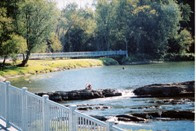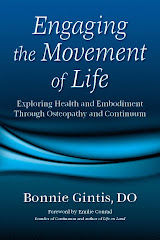This year I say, "Heck with the cards and presents and candles!" I'm sitting at a window or lying down by a window and watching the river flow. It keeps me present and aware of something other than my own internal drama and suffering.
Cancer is my proving ground for how serious I am about living. It's become my life's work to learn how to be with this disease and all that it brings and find a way to make peace with it. I'm in less pain when I am in a state of internal acceptance (not to be confused with "giving up"). It is in this state that I make wise choices about my life. Every little move - how I lift a pan, how I reach for a roll of toilet paper on a high shelf (a challenge living with 6 foot 4 inch Steve who puts things away in places I don't know exist) what I commit to do when invited to a party, how I exercise, how many errands I run in a day, and what I plan to do with my future effects my daily pain level. Consciousness is potent medicine! I'm continuously learning how to cultivate the consciousness that allows me to live and thrive. My most challenging struggle is giving up being an overachiever.
I have just not been motivated to write for other people for a while. I'm trying to respond to everything that comes up inside me that feels like a "should." I'm sorry if you've been waiting to hear from me. My tempo is unbelievably slowed down and I haven't been able to crank out blog entries that meet my literary standards, or even just report on current events, but I will try...
Our apartment is feeling a lot more like home. Having a couch (we love our new couch) and proper lighting helps. 15 foot ceilings with no ceiling light fixtures makes lighting a serious challenge. We've had to be creative in figuring out ways to light up the house effectively. The people in this building, especially the poor college students, joke about what happens to the vision of Woolen Mill tenants from living in dim light. Those of us who face the river get some pretty bright light in the daytime when the sun rises over the river, but by 2 pm it's fairly dim inside. We're still in search of a few lighting fixtures for some dark corners.
We did our first little dance of apartment living celebration when it snowed and someone else shoveled. Apartment life is the best!
I found a wonderful Tai Chi teacher (http://greenleaftaichi.com/about/), who does Tai Chi as if it were standing and walking Continuum. He teaches the form or sequence of movements along with some principles that describe the movement of chi. Then he has us make up movements of our own, feeling the chi and using the imaginal mind to apply principles like, "walking under water," "pushing clouds," or "pushing a beachball under water." Sometimes we play the childhood game, "Red Light Green Light" in which he has us move on our own and stop randomly with a call of "red light," and we see if we can sense the energy and suspend right where we are in a balanced way. We pause, feel what's moving and what's not, make a little adjustment if we need to fine-tune our balance, and then after calling "green light" we start moving again. In 8 weeks we will learn the "Wu" style or "art of the water school" short form. He hopes we integrate the principles into how we move in our daily mundane life. He's quite young, but he totally "gets it," unlike many young people who seem to primarily be in search of "Buns of Steel" or some other useless bodily transformation. He's got a great future as a teacher, and I'm happy to have discovered him now.
I love the movement studio across the bridge. If you look at the photo taken from my living room on my Facebook page, it's the building across the bridge in the distance in the center of the photo. It takes 3 minutes to walk there. There's a walkway under the bridge that feels like a magic gateway to get to the other side. I go there once or twice a week for some class. My current favorite is this one:
Total Body Connectivity: The best way for students seeking to integrate and enhance body-mind connectivity. This class combines Bartenieff Fundamentals, Delsarte System of Expression, and Laban Movement Analysis for essential Awareness, Balance, and Coordination practices.It may sound more "structured" than you Continuum folks might think I would enjoy, but it isn't. It's very spacious and inner-directed. That's how Lucille approaches all her teaching, acknowledging that everything, hence all movement arises from "nothing." There's no better place to be!
I also found more than one great massage therapist, a wonderful Hakomi practitioner/therapist, and an acupuncturist who has a special interest in treating people with cancer. I've assembled quite a team, all within 15 minutes from home!
We have seen/heard some great live music: one-woman solo marimba, Gogol Bordello (gypsy punk rock), Cuban jazz, and Regina Carter, a fabulous jazz violinist at the UVM recital hall, a room with some of the best acoustics I've ever heard, and only 300 seats. UVM actually stands for Universitas Virdis Montis, latin for University of the Green Mountains, not University of Vermont, although that's what it actually is. Regina Carter is a MacArthur Fellow this year and has done an amazing job researching African folk music and synthesizing it into her jazz. Check out her new album: http://www.reginacarter.com/
Burlington has so much for such a small place. The indoor winter farmer's market is in full swing and our little Winooski downtown has some new "pop up" stores and a gallery that will probably just be here for the holiday season. The downtown landlords rent out empty store fronts very inexpensively to artists and artisans in attempt to stir up interest in the growing groovy neighborhood. I am sure this place will make it, and although I wish it "were there" already, at least there is the excitement of watching it turn into an interesting place. The food coop has plans to open a branch here in a building that's starting construction in the spring. Yay! Great food just around the traffic circle, about a 90 second walk from home.
It's been dipping into the single digits at night and I'm loving getting bundled up. I go into one of my favorite stores downtown, Outdoor Gear Exchange at least once a week asking advice about some winter weather garment that didn't exist 15 years ago. It's amazing how the technology of keeping warm has improved. Remember my Norwegian friend's advice, "There's no such thing as bad weather, only bad clothing."
No big snow yet, just a few inches one day and a few dustings that melted quickly. We had a mallard couple (they are known to pair for life) who moved in to a calm spot on our river for almost 2 months. They swam in circles all day together, seemingly unfazed by the treaturous waterfalls on one side and a dam on the other. They were my heroes and the subject of many staring-out-the-window-at-the-river meditations until they flew south a few weeks ago. We have a fair number of non-migrating seagulls here that huddle on the rocks in the half-frozen river and some small dark birds that fly in swarms and swoop over the river. I could watch them all day, and sometimes I do!
My 17-yr-old step-son Luke is arriving tonight from Santa Cruz. Won't he be surprised when he feels single digit weather for the first time?! We have extra layers ready for him. His 19-yr-old brother arrives next week from Berkeley. Luke goes back first, so that we'll have time alone with each of them on either end of our time together. We'll be off to listen to more music, see some movies, play Settlers of Catan, snowboard (I'll read and drink tea in the ski lodge), go to Montreal for the day (90 miles north across the border), splash and scream at Vermont's new indoor water park (http://www.jaypeakresort.com/#/water_park/), and eat lots of great food. I'll rest a lot while they run around, and enjoy being with them, even if I can't keep up with their pace.
After they are gone, I enter a whole new phase of life. Steve goes back to work on January 17th. Check out his new website, even though it's still under construction you'll get an idea of the face of his new practice: http://stevepaulus.com/Office_Website/Home.html. I begin a mini-retreat/training at the Burlington Shambhala Center (http://burlington.shambhala.org/
and I go for my 6-month oncology work-up. I'll keep you posted as the results of my scans come in late January. By then, I'll be immersed in my favorite paradox of the year; as the days are getting lighter, the temperature and snow are still falling. I will be rising to the occasion to discover and honor the rhythm of this next phase of life.













